United States Navy
| United States Navy | |
|---|---|
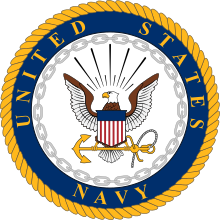 Emblem of the United States Navy | |
| Founded | 27 March 1794 (230 years) (in current form) 13 October 1775 |
| Country | |
| Type | Navy |
| Size | 334,896 active duty personnel [3] 54,741 Navy Reserve personnel [4] 387,637 total uniformed personnel (official data as of July 31, 2023) 279,471 civilian employees (As of 2018[update])[5] 480 ships total, of which 300 are deployable (As of 2019[update])[5] 2,623 aircraft (As of 2018[update])[6] |
| Part of | United States Armed Forces Department of the Navy |
| Headquarters | The Pentagon Arlington County, Virginia, U.S. |
| Motto(s) | Semper Fortis ('Always Courageous'), (unofficial). Non sibi sed patriae ('Not for self but for country') (unofficial) |
| Colors | Blue and gold[7][8] |
| March | "Anchors Aweigh" ⓘ |
| Anniversaries | 13 October |
| Equipment | List of equipment of the United States Navy |
| Engagements | See list
|
| Website | |
| Commanders | |
James W. Kilby | |
| Master Chief Petty Officer of the Navy | |
| Insignia | |
| Flag |  |
| Ensign |  |
| Jack |  |
| Pennant | |
| Logo |  |
| United States Armed Forces |
|---|
 |
| Executive departments |
| Staff |
| Military departments |
| Military services |
| Command structure |
The United States Navy (USN) is the maritime service branch of the United States Armed Forces and one of the eight uniformed services of the United States. It is the world's most powerful navy and the largest by tonnage, at 4.5 million tons in 2021[9] and in 2009 an estimated battle fleet tonnage that exceeded the next 13 navies combined.[10] It has the world's largest aircraft carrier fleet, with 11 in service, 1 undergoing trials, two new carriers under construction, and six other carriers planned as of 2024. With 336,978 personnel on active duty and 101,583 in the Ready Reserve, the U.S. Navy is the third largest of the United States military service branches in terms of personnel. It has 299 deployable combat vessels and about 4,012 operational aircraft as of July 18, 2023.[11][12]
The United States Navy traces its origins to the
The United States Navy is part of the Department of the Navy, alongside the United States Marine Corps, which is its coequal sister service. The Department of the Navy is headed by the civilian secretary of the Navy. The Department of the Navy is itself a military department of the Department of Defense, which is headed by the secretary of defense. The chief of naval operations (CNO) is the most senior Navy officer serving in the Department of the Navy.[13]
Mission
To recruit, train, equip, and organize to deliver combat ready Naval forces to win conflicts and wars while maintaining security and deterrence through sustained forward presence.
— Mission statement of the United States Navy.[14]
The U.S. Navy is a seaborne branch of the
- The preparation of naval forces necessary for the effective prosecution of war.
- The maintenance of naval aviation, including land-based naval aviation, air transport essential for naval operations, and all air weapons and air techniques involved in the operations and activities of the Navy.
- The development of aircraft, weapons, naval combatand service elements.
U.S. Navy training manuals state that the mission of the U.S. Armed Forces is "to be prepared to conduct prompt and sustained combat operations in support of the national interest." The Navy's five enduring functions are:
History
Origins
It follows then as certain as that night succeeds the day, that without a decisive naval force we can do nothing definitive, and with it, everything honorable and glorious.
—Marquis de Lafayette[17]
Would to Heaven we had a navy able to reform those enemies to mankind or crush them into non-existence.
— George Washington 15 August 1786, to Marquis de Lafayette[18]
Naval power . . . is the natural defense of the United States.
The Navy was rooted in the colonial seafaring tradition, which produced a large community of sailors, captains, and shipbuilders.[20] In the early stages of the American Revolutionary War, Massachusetts had its own Massachusetts Naval Militia. The rationale for establishing a national navy was debated in the Second Continental Congress. Supporters argued that a navy would protect shipping, defend the coast, and make it easier to seek support from foreign countries. Detractors countered that challenging the British Royal Navy, then the world's preeminent naval power, was a foolish undertaking. Commander in Chief George Washington resolved the debate when he commissioned the ocean-going schooner USS Hannah to interdict British merchantmen and reported the captures to the Congress. On 13 October 1775, the Continental Congress authorized the purchase of two vessels to be armed for a cruise against British merchantmen; this resolution created the Continental Navy and is considered the first establishment of the U.S. Navy.[21] The Continental Navy achieved mixed results; it was successful in a number of engagements and raided many British merchant vessels, but it lost twenty-four of its vessels[22] and at one point was reduced to two in active service.[23] In August 1785, after the Revolutionary War had drawn to a close, Congress had sold Alliance, the last ship remaining in the Continental Navy due to a lack of funds to maintain the ship or support a navy.[24][25]
In 1972, the Chief of Naval Operations, Admiral Elmo Zumwalt, authorized the Navy to celebrate its birthday on 13 October to honor the establishment of the Continental Navy in 1775.[26][21]
From re-establishment to the Civil War
The United States was without a navy for nearly a decade, a state of affairs that exposed U.S. maritime merchant ships to a series of attacks by the
The U.S. Navy saw substantial action in the War of 1812, where it was victorious in eleven single-ship duels with the Royal Navy. It proved victorious in the Battle of Lake Erie and prevented the region from becoming a threat to American operations in the area. The result was a major victory for the U.S. Army at the Niagara Frontier of the war, and the defeat of the Native American allies of the British at the Battle of the Thames. Despite this, the U.S. Navy could not prevent the British from blockading its ports and landing troops.[31] But after the War of 1812 ended in 1815, the U.S. Navy primarily focused its attention on protecting American shipping assets, sending squadrons to the Caribbean, the Mediterranean, where it participated in the Second Barbary War that ended piracy in the region, South America, Africa, and the Pacific.[22] From 1819 to the outbreak of the Civil War, the Africa Squadron operated to suppress the slave trade, seizing 36 slave ships, although its contribution was smaller than that of the much larger British Royal Navy. After 1840 several secretaries of the navy were southerners who advocated for strengthening southern naval defenses, expanding the fleet, and making naval technological improvements.[32]

During the
Naval power played a significant role during the
20th century

A modernization program beginning in the 1880s when the first steel-hulled warships stimulated the American steel industry, and "the new steel navy" was born.
World War I and interwar years
During
Naval construction, especially of battleships, was limited by the
World War II
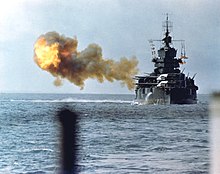
The U.S. Navy grew into a formidable force in the years prior to

Doctrine had significantly shifted by the end of the war. The U.S. Navy had followed in the footsteps of the navies of Great Britain and Germany which favored concentrated groups of battleships as their main offensive naval weapons.[43] The development of the aircraft carrier and its devastating use by the Japanese against the U.S. at Pearl Harbor, however, shifted U.S. thinking. The Pearl Harbor attack destroyed or took out of action a significant number of U.S. Navy battleships. This placed much of the burden of retaliating against the Japanese on the small number of aircraft carriers.[44] During World War II some 4,000,000 Americans served in the United States Navy.[45]
Cold War and 1990s
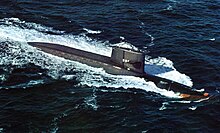
The potential for armed conflict with the Soviet Union during the Cold War pushed the U.S. Navy to continue its technological advancement by developing new weapons systems, ships, and aircraft. U.S. naval strategy changed to that of forward deployment in support of U.S. allies with an emphasis on carrier battle groups.[46]
The navy was a major participant in the
The U.S. Navy has also been involved in search and rescue/search and salvage operations, sometimes in conjunction with vessels of other countries as well as with U.S. Coast Guard ships. Two examples are the 1966 Palomares B-52 crash incident and the subsequent search for missing hydrogen bombs, and Task Force 71 of the Seventh Fleet's operation in search for Korean Air Lines Flight 007, shot down by the Soviets on 1 September 1983.
21st century
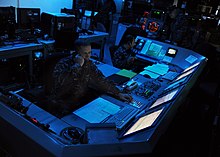
The U.S. Navy continues to be a major support to U.S. interests in the 21st century. Since the end of the Cold War, it has shifted its focus from preparations for large-scale war with the Soviet Union to special operations and strike missions in regional conflicts.
In 2007, the U.S. Navy joined with the
The strategy recognized the economic links of the global system and how any disruption due to regional crises (man-made or natural) can adversely impact the U.S. economy and quality of life. This new strategy charts a course for the Navy, Coast Guard, and Marine Corps to work collectively with each other and international partners to prevent these crises from occurring or reacting quickly should one occur to prevent negative impacts on the U.S.
In 2010, Admiral Gary Roughead, Chief of Naval Operations, noted that demands on the Navy have grown as the fleet has shrunk and that in the face of declining budgets in the future, the U.S. Navy must rely even more on international partnerships.[50]
In its 2013 budget request, the navy focused on retaining all eleven big deck carriers, at the expense of cutting numbers of smaller ships and delaying the SSBN replacement.
One significant change in U.S. policymaking that is having a major effect on naval planning is the
Organization
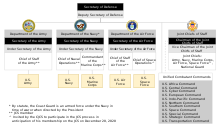
The U.S. Navy falls under the administration of the Department of the Navy, under civilian leadership of the Secretary of the Navy (SECNAV). The most senior naval officer is the Chief of Naval Operations (CNO), a four-star admiral who is immediately under and reports to the Secretary of the Navy. At the same time, the Chief of Naval Operations is a member of the Joint Chiefs of Staff, which is the second-highest deliberative body of the armed forces after the United States National Security Council, although it plays only an advisory role to the President and does not nominally form part of the chain of command. The Secretary of the Navy and Chief of Naval Operations are responsible for organizing, recruiting, training, and equipping the Navy so that it is ready for operation under the commanders of the unified combatant commands.
Operating forces
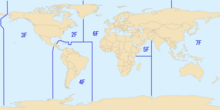
There are nine components in the operating forces of the U.S. Navy: the
The United States Navy has seven active numbered fleets – Second, Third, Fifth, Sixth, Seventh and Tenth Fleets are each led by a vice admiral, and the Fourth Fleet is led by a rear admiral. These seven fleets are further grouped under Fleet Forces Command (the former Atlantic Fleet), Pacific Fleet, Naval Forces Europe-Africa, and Naval Forces Central Command, whose commander also doubles as Commander Fifth Fleet; the first three commands being led by four-star admirals. The United States First Fleet existed after World War II from 1947, but it was redesignated the Third Fleet in early 1973. The Second Fleet was deactivated in September 2011 but reestablished in August 2018 amid heightened tensions with Russia.[57] It is headquartered in Norfolk, Virginia, with responsibility over the East Coast and North Atlantic.[58] In early 2008, the Navy reactivated the Fourth Fleet to control operations in the area controlled by Southern Command, which consists of US assets in and around Central and South America.[59] Other number fleets were activated during World War II and later deactivated, renumbered, or merged.
Shore establishments
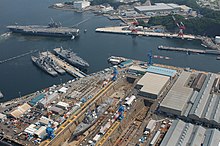
Shore establishments exist to support the mission of the fleet through the use of facilities on land. Among the commands of the shore establishment, as of April 2011[update], are the
Relationships with other service branches
United States Marine Corps
In 1834, the United States Marine Corps came under the Department of the Navy.[62] Historically, the Navy has had a unique relationship with the USMC, partly because they both specialize in seaborne operations. Together the Navy and Marine Corps form the Department of the Navy and report to the Secretary of the Navy. However, the Marine Corps is a distinct, separate service branch[63] with its own uniformed service chief – the Commandant of the Marine Corps, a four-star general.
The Marine Corps depends on the Navy for medical support (dentists,
In the operational environment, as an expeditionary force specializing in amphibious operations, Marines often embark on Navy ships to conduct operations from beyond territorial waters. Marine units deploying as part of a Marine Air-Ground Task Force (MAGTF) operate under the command of the existing Marine chain of command. Although Marine units routinely operate from amphibious assault ships, the relationship has evolved over the years much as the Commander of the Carrier Air Group/Wing (CAG) does not work for the carrier commanding officer, but coordinates with the ship's CO and staff. Some Marine aviation squadrons, usually fixed-wing assigned to carrier air wings train and operate alongside Navy squadrons; they fly similar missions and often fly sorties together under the cognizance of the CAG. Aviation is where the Navy and Marines share the most common ground since aircrews are guided in their use of aircraft by standard procedures outlined in a series of publications known as
United States Coast Guard

The
Personnel
The United States Navy has over 400,000 personnel, approximately a quarter of whom are in ready reserve. Of those on active duty, more than eighty percent are
Enlisted sailors complete basic military training at boot camp and then are sent to complete training for their individual careers.[65]
Sailors prove they have mastered skills and deserve responsibilities by completing Personnel Qualification Standards (PQS) tasks and examinations. Among the most important is the "warfare qualification", which denotes a journeyman level of capability in Surface Warfare, Aviation Warfare, Information Dominance Warfare, Naval Aircrew, Special Warfare, Seabee Warfare, Submarine Warfare or Expeditionary Warfare. Many qualifications are denoted on a sailor's uniform with U.S. Navy badges and insignia.
Uniforms
The uniforms of the U.S. Navy have evolved gradually since the first uniform regulations for
Commissioned officers
US DoD
pay grade |
Special grade[a] | O-10 | O-9 | O-8 | O-7 | O-6 | O-5 | O-4 | O-3 | O-2 | O-1 |
|---|---|---|---|---|---|---|---|---|---|---|---|
| NATO code | OF-10 | OF-9 | OF-8 | OF-7 | OF-6 | OF-5 | OF-4 | OF-3 | OF-2 | OF-1 | |
| Insignia | 
|
||||||||||
| Uniform insignia | |||||||||||
| Title | Fleet admiral | Admiral | Vice admiral | Rear admiral | Rear admiral (lower half) | Captain | Commander | Lieutenant commander | Lieutenant | Lieutenant (junior grade) | Ensign |
| Abbreviation | FADM | ADM | VADM | RADM | RDML | CAPT | CDR | LCDR | LT | LTJG | ENS |
- ^ Reserved for wartime use only.
Navy officers serve either as a
| Type | Line officer | Medical Corps |
Dental Corps |
Nurse Corps |
Medical Service Corps | Judge Advocate General's Corps
|
|---|---|---|---|---|---|---|
| Insignia | 
|

| ||||
Designator 1 |
1XXX | 210X | 220X | 290X | 230X | 250X |
Chaplain Corps (Christian Faith) |
(Jewish Faith) |
(Muslim Faith) |
(Buddhist Faith) |
Supply Corps | Civil Engineer Corps | Law Community
(Limited Duty Officer) |

|

|
|||||
| 410X | 410X | 410X | 410X | 310X | 510X | 655X |
Warrant officers
| US DoD pay grade | W-5 | W-4 | W-3 | W-2 | W-1 |
|---|---|---|---|---|---|
| NATO code | WO-5 | WO-4 | WO-3 | WO-2 | WO-1 |
| Insignia | 
|

|

|

|

|
| Title | Chief warrant officer 5 | Chief warrant officer 4 | Chief warrant officer 3 | Chief warrant officer 2 | Warrant officer 1
|
| Abbreviation | CWO-5 | CWO-4 | CWO-3 | CWO-2 | WO-1 |
Warrant and chief warrant officer ranks are held by technical specialists who direct specific activities essential to the proper operation of the ship, which also require commissioned officer authority.[69] Navy warrant officers serve in 30 specialties covering five categories. Warrant officers should not be confused with the limited duty officer (LDO) in the Navy. Warrant officers perform duties that are directly related to their previous enlisted service and specialized training. This allows the Navy to capitalize on the experience of warrant officers without having to frequently transition them to other duty assignments for advancement.[70] Most Navy warrant officers are accessed from the chief petty officer pay grades, E-7 through E-9, analogous to a senior non-commissioned officer in the other services, and must have a minimum 14 years in service.[71]
Enlisted
Sailors in pay grades E-1 through E-3 are considered to be in apprenticeships.[72] They are divided into five definable groups, with colored group rate marks designating the group to which they belong: Seaman, Fireman, Airman, Constructionman, and Hospitalman. E-4 to E-6 are non-commissioned officers (NCOs), and are specifically called Petty officers in the Navy.[73] Petty Officers perform not only the duties of their specific career field but also serve as leaders to junior enlisted personnel. E-7 to E-9 are still considered Petty Officers, but are considered a separate community within the Navy. They have separate berthing and dining facilities (where feasible), wear separate uniforms, and perform separate duties.
After attaining the rate of Master Chief Petty Officer, a service member may choose to further their career by becoming a
CMC insignia are similar to the insignia for Master Chief, except that the rating symbol is replaced by an inverted five-point star, reflecting a change in their rating from their previous rating (i.e., MMCM) to CMDCM. The stars for Command Master Chief are silver, while stars for Fleet or Force Master Chief are gold. Additionally, CMCs wear a badge, worn on their left breast pocket, denoting their title (Command/Fleet/Force).[75][77]
| US DoD pay grade |
Special | E-9 | E-8 | E-7 | E-6 | E-5 | E-4 | E-3 | E-2 | E-1 | ||||
|---|---|---|---|---|---|---|---|---|---|---|---|---|---|---|
| NATO code | OR-9 | OR-8 | OR-7 | OR-6 | OR-5 | OR-4 | OR-3 | OR-2 | OR-1 | |||||
| Sleeve insignia | 
|

|

|

|

|

|

|

|

|

|

|

|

|
No insignia |
| Title | Senior Enlisted Advisor to the Chairman | Master Chief Petty Officer of the Navy | Fleet/force master chief petty officer | Command master chief petty officer | Master chief petty officer | Command senior chief petty officer | Senior chief petty officer | Chief petty officer | Petty officer first class | Petty officer second class | Petty officer third class | Seaman | Seaman apprentice | Seaman recruit |
| Abbreviation | SEAC | MCPON | FLTCM/FORCM | CMDCM | MCPO | CMDCS | SCPO | CPO | PO1 | PO2 | PO3 | SN | SA | SR |
Insignia and badges of the United States Navy are military "badges" issued by the Department of the Navy to naval service members who achieve certain qualifications and accomplishments while serving on both active and reserve duty in the United States Navy. Most naval aviation insignia are also permitted for wear on uniforms of the United States Marine Corps.
As described in Chapter 5 of U.S. Navy Uniform Regulations,[78] "badges" are categorized as breast insignia (usually worn immediately above and below ribbons) and identification badges (usually worn at breast pocket level).[79] Breast insignia are further divided between command and warfare and other qualification.[80]
Insignia come in the form of metal "pin-on devices" worn on formal uniforms and embroidered "tape strips" worn on work uniforms. For the purpose of this article, the general term "insignia" shall be used to describe both, as it is done in Navy Uniform Regulations. The term "badge", although used ambiguously in other military branches and in informal speak to describe any pin, patch, or tab, is exclusive to identification badges
-
Naval Aviator Badge
-
Submarine Officer badge
-
Surface Warfare Officer Insignia
Bases
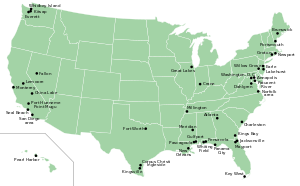
The size, complexity, and international presence of the United States Navy requires a large number of navy installations to support its operations. While the majority of bases are located inside the United States itself, the Navy maintains a significant number of facilities abroad, either in U.S.-controlled territories or in foreign countries under a
Eastern United States
The second largest concentration of installations is at
There is also a naval base in Charleston, South Carolina. This is home to the Naval Nuclear Power Training Command, under which reside the Nuclear Field "A" Schools (for Machinist Mates (Nuclear), Electrician Mates (Nuclear), and Electronics Technicians (Nuclear)), Nuclear Power School (Officer and Enlisted); and one of two Nuclear Power Training Unit 'Prototype' schools. The state of Florida is the location of three major bases,
The main U.S. Navy
The Washington Navy Yard in Washington, DC is the Navy's oldest shore establishment and serves as a ceremonial and administrative center for the U.S. Navy, home to the Chief of Naval Operations and numerous commands.
Western United States and Hawaii
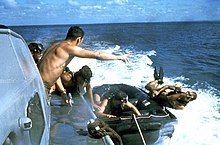
The U.S. Navy's largest complex is Naval Air Weapons Station China Lake, California, which covers 1.1 million acres (4,500 km2) of land, or approximately one-third of the U.S. Navy's total land holdings.[5]
The other major collection of naval bases on the west coast is in
United States territories

Guam, an island strategically located in the Western Pacific Ocean, maintains a sizable U.S. Navy presence, including NB Guam. The westernmost U.S. territory, it contains a natural deepwater harbor capable of harboring aircraft carriers in emergencies.[citation needed] Its naval air station was deactivated[citation needed] in 1995 and its flight activities transferred to nearby Andersen Air Force Base.
Puerto Rico in the Caribbean formerly housed NS Roosevelt Roads, which was shut down in 2004 shortly after the controversial closure of the live ordnance training area on nearby Vieques Island.[5]
Foreign countries
The largest overseas base is the United States Fleet Activities Yokosuka, Japan, which serves as the home port for the navy's largest forward-deployed fleet and is a significant base of operations in the Western Pacific.[citation needed]
European operations revolve around facilities in Italy (
In the Middle East, naval facilities are located almost exclusively in countries bordering the
NS Guantanamo Bay in Cuba is the oldest overseas facility and has become known in recent years as the location of a detention camp for suspected al-Qaeda operatives.[85]
Equipment

As of 2018[update], the navy operates over 460 ships (including vessels operated by the Military Sealift Command), 3,650+ aircraft, 50,000 non-combat vehicles and owns 75,200 buildings on 3,300,000 acres (13,000 km2).
Ships
The names of commissioned ships of the U.S. Navy are prefixed with the letters "USS", designating "United States Ship".[86] Non-commissioned, civilian-manned vessels of the navy have names that begin with "USNS", standing for "United States Naval Ship". The names of ships are officially selected by the secretary of the navy, often to honor important people or places.[87] Additionally, each ship is given a letter-based hull classification symbol (for example, CVN or DDG) to indicate the vessel's type and number. All ships in the navy inventory are placed in the Naval Vessel Register, which is part of "the Navy List" (required by article 29 of the United Nations Convention on the Law of the Sea).[dubious ] The register tracks data such as the current status of a ship, the date of its commissioning, and the date of its decommissioning. Vessels that are removed from the register prior to disposal are said to be stricken from the register. The navy also maintains a reserve fleet of inactive vessels that are maintained for reactivation in times of need.
The U.S. Navy was one of the first to install nuclear reactors aboard naval vessels.[88] Today, nuclear energy powers all active U.S. aircraft carriers and submarines.
In early 2010, the U.S. Navy had identified a need for 313 combat ships but could only afford 232 to 243 ships.[89] In March 2014, the Navy started counting self-deployable support ships such as minesweepers, surveillance craft, and tugs in the "battle fleet" to reach a count of 272 as of October 2016,[90][91] and it includes ships that have been put in "shrink wrap".[92] The number of ships generally ranged between 270 and 300 throughout the late 2010s.[93] As of February 2022, the Navy has 296 battle force ships, however analyses state the Navy needs a fleet of more than 500 to meet its commitments.[94][95]
Aircraft carriers
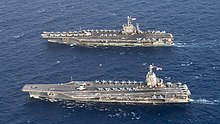
The Navy has a statutory requirement for a minimum of 11 aircraft carriers.[97] All 11 carriers are currently active, ten Nimitz-class and one Gerald R. Ford-class.
Aircraft Carrier Capacity
Aircraft Carriers have the ability to house 5,000 people. This is the size of a small town floating in the ocean. Aircraft carriers also have up to 90 aircraft on the ship at one time.
Amphibious warfare ships

The dock landing ship is a medium amphibious transport that is designed specifically to support and operate LCACs, though it is able to operate other amphibious assault vehicles in the United States inventory as well. Dock landing ships are normally deployed as a component of an expeditionary strike group's amphibious assault contingent, operating as a secondary launch platform for LCACs. All dock landing ships are named after cities or important places in U.S. and U.S. Naval history.[96]
The Navy operates 32 amphibious warfare ships, eight Wasp class and two America class amphibious assault ships, four Harpers Ferry class and six Whidbey Island class dock landing ships, and 12 San Antonio class amphibious transport dock ships.
Cruisers

Destroyers
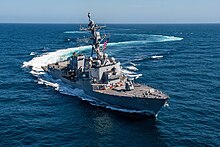
The U.S. Navy currently has 75 destroyers, 73 Arleigh Burke-class destroyers and two Zumwalt-class stealth destroyers, with a third (the USS Lyndon B. Johnson) expected to enter service sometime in 2024.[98]
Frigates and Littoral combat ships

Modern U.S. frigates mainly perform anti-submarine warfare for carrier and expeditionary strike groups and provide armed escort for supply convoys and merchant shipping. They are designed to protect friendly ships against hostile submarines in low to medium threat environments, using torpedoes and LAMPS helicopters. Independently, frigates are able to conduct counterdrug missions and other maritime interception operations. As in the case of destroyers, frigates are named after U.S. Navy, Marine Corps, and Coast Guard heroes.
In late 2015, the U.S. Navy retired its most recent class of traditional frigates in favor of the littoral combat ship (LCS), relatively small vessels designed for near-shore operations that was expected to assume many of the duties the frigate had with the fleet. The LCS was "envisioned to be a networked, agile, stealthy surface combatant capable of defeating anti-access and asymmetric threats in the littorals",[99] although their ability to perform these missions in practice has been called into question.[100] The Navy has announced it plans to reduce procurement of the LCS and retire early examples of the type.
In the future, the Navy plans to purchase up to 20 of the Constellation-class frigate, based on the FREMM multipurpose frigate, already in service with European navies.
The U.S. Navy currently has 23 littoral combat ships, eight Freedom-class and 15 Independence-class ships.

A special case is the USS Constitution, commissioned in 1797 as one of the original six frigates of the United States Navy and which remains in commission at the Charlestown Navy Yard in Boston. She occasionally sails for commemorative events such as Independence Day.
Mine countermeasures ships
Mine countermeasures vessels are a combination of minehunters, a naval vessel that actively detects and destroys individual naval mines, and minesweepers, which clear mined areas as a whole, without prior detection of the mines. MCM vessels have mostly legacy names of previous US Navy ships, especially World War II-era minesweepers.
The Navy operates eight Avenger-class mine countermeasures ships, with four expected to be retired in 2024.
Submarines
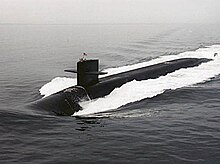
The U.S. Navy operates three types of submarines:
Attack submarines typically operate as part of a
The Navy operates 69 submarines, 29 Los Angeles class attack submarines (with two more in reserve), 18 Ohio class submarines with 14 configured as ballistic missile submarines and four configured as guided missile submarines, three Seawolf class attack submarines, and 19 Virginia class attack submarines.
Aircraft
Carrier-based aircraft are able to strike air, sea, and land targets far from a carrier strike group while protecting friendly forces from enemy aircraft, ships, and submarines. In peacetime, aircraft's ability to project the threat of sustained attack from a mobile platform on the seas gives United States leaders significant diplomatic and crisis-management options. Aircraft additionally provide logistics support to maintain the navy's readiness and, through helicopters, supply platforms with which to conduct
The U.S. Navy began to research the use of aircraft at sea in the 1910s, with Lieutenant Theodore G. "Spuds" Ellyson becoming the first naval aviator on 28 January 1911, and commissioned its first aircraft carrier,
The Aircraft Investment Plan sees naval aviation growing from 30 percent of current aviation forces to half of all procurement funding over the next three decades.[103]
Weapons

Current U.S. Navy shipboard weapons systems are almost entirely focused on missiles, both as a weapon and as a threat. In an offensive role, missiles are intended to strike targets at long distances with accuracy and precision. Because they are unmanned weapons, missiles allow for attacks on heavily defended targets without risk to human pilots. Land strikes are the domain of the BGM-109 Tomahawk, which was first deployed in the 1980s and is continually being updated to increase its capabilities. For anti-ship strikes, the navy's dedicated missile is the
Naval fixed-wing aircraft employ much of the same weapons as the
Rotary aircraft weapons are focused on anti-submarine warfare (ASW) and light to medium surface engagements. To combat submarines, helicopters use Mark 46 and Mark 50 torpedoes. Against small watercraft, they use
Nuclear weapons in the U.S. Navy arsenal are deployed through ballistic missile submarines and aircraft. The Ohio-class submarine carries the latest iteration of the


The current
Notable sailors
Many past and present United States historical figures have served in the U.S. Navy.
Officers
Notable officers include:
- John P. Jones
- John Barry (Continental Navy officer and first flag officer of the United States Navy),[106]
- Edward Preble
- James Lawrence (whose last words "don't give up the ship" are memorialized in Bancroft Hall at the United States Naval Academy)[107]
- ,
- Commodore Matthew C. Perry (who, under the direction of President Millard Fillmore, forced the opening of Japan[108]
- George Dewey (the only person in U.S. history to have attained the rank of Admiral of the Navy[109]
- William D. Leahy[110]
- Ernest J. King[110]
- Chester W. Nimitz[110]
- William F. Halsey Jr.[110]
Presidents
The first American President who served in the U.S. Navy was
Government officials
Some notable former members of the Navy include
Others
Notable former members of the U.S. Navy include; astronauts (
See also
- Bibliography of early United States naval history
- Columbia-class submarine
- List of undesignated military aircraft of the United States
- List of United States Navy aircraft designations (pre-1962)
- List of United States Navy ships
- Lists of military aircraft of the United States
- Modern United States Navy carrier air operations
- Naval militia
- expeditionary fast transport
- United States Merchant Marine Academy
- Women in the United States Navy
- Army and Navy stamp issues of 1936–1937
References
- Naval History & Heritage Command. 4 October 2009. Archived from the originalon 11 March 2010. Retrieved 14 February 2010.
- ^ [Strength Changes (Last 12 Months)
- ^ [1] Archived 18 September 2023 at the Wayback Machine, DMDC official website, accessed 14 September 2023
- ^ a b c d e f "Current Navy Demographics Quarterly Report". navy.mil. 14 June 2018. Archived from the original on 14 June 2018. Retrieved 1 May 2022.
- ^ "World Air Forces 2018". flightglobal.com. p. 17. Archived from the original on 14 June 2018. Retrieved 1 May 2022.(registration required)
- ^ "Customs and Traditions, Navy". History.Navy.mil. United States Navy. Archived from the original on 20 August 2022. Retrieved 27 August 2022.
The official Navy colors are blue and gold
- ^ "America's Navy Color Palette: Digital" (PDF). United States Navy Licensing Guide. 8 April 2021. Archived (PDF) from the original on 31 August 2022. Retrieved 27 August 2022.
- ^ Axe, David (10 November 2021). "Yes, The Chinese Navy Has More Ships Than The U.S. Navy. But It's Got Far Fewer Missiles". Forbes. Retrieved 12 April 2024.
- ^ "The Russian Navy Is Aiming To Be Much Larger Than The US Navy". Business Insider. 24 September 2014. Archived from the original on 26 November 2015. Retrieved 12 November 2015.
- ^ "Navy Raises Battle Force Goal to 381 Ships in Classified Report to Congress". United States Naval Institute. Archived from the original on 15 November 2023. Retrieved 13 October 2023.
- ^ "Navy aircraft inventory by type U.S. 2024". Statista. Archived from the original on 7 November 2023. Retrieved 14 October 2023.
- ^ "Responsibilities". Chief of Naval Operations. United States Navy. Archived from the original on 24 June 2013. Retrieved 15 June 2013.
- ^ 10 U.S.C. § 5062
- ^ "Naval Warfare 2010–2020: A Comparative Analysis". 6 August 2020. Archived from the original on 28 January 2021. Retrieved 13 October 2020.
- ^ "George Washington to Marie Joseph Paul Yves Roch Gilbert du Motier, Marquis de Lafayette, August 15, 1786". Library of Congress. Archived from the original on 26 April 2020. Retrieved 31 May 2019.
- ISBN 978-1-61251-892-3. Archivedfrom the original on 31 January 2021. Retrieved 29 October 2020.
- ISBN 978-0-8032-4471-9. Archivedfrom the original on 26 January 2016. Retrieved 17 October 2015.
- ^ Naval History & Heritage Command. US Navy. Archived from the originalon 4 February 1999. Retrieved 5 November 2009.
- ^ ISBN 978-0-8117-1862-2.
- ^ ISBN 0-394-57662-4.
- ^ "Alliance". Dictionary of American Naval Fighting Ships. Navy Department, Naval History and Heritage Command. Retrieved 31 August 2009.
- ^ Abbot 1896, Volume I Part I Chapter XV
- ^ "Launching the New U.S. Navy, 27 March 1794". National Archives and Records Administration Center for Legislative Archives Records of the U.S. Senate Record Group 46. 15 August 2016. Archived from the original on 7 January 2011. Retrieved 1 July 2017.
- ISBN 978-0735224711.
- ^ "John Adams I (Frigate) 1799–1867". USA.gov. Archived from the original on 9 September 2015. Retrieved 22 August 2015.
- ^ Randal Rust. "Quasi-War". R.Squared Communications. Archived from the original on 15 April 2017. Retrieved 5 April 2017.
- ^ a b c Palmer, Michael A. "The Navy: The Continental Period, 1775–1890". Naval History and Heritage Command. Archived from the original on 30 June 2015. Retrieved 20 June 2015.
- ^ Karp, Matthew J. "Slavery and American Sea Power: The Navalist Impulse in the Antebellum South." The Journal of Southern History, vol. 77, no. 2, 2011, p. 317. JSTOR website Archived 12 January 2023 at the Wayback Machine Retrieved 12 Jan. 2023.
- ISBN 978-0-8078-3588-3. Archivedfrom the original on 26 January 2016. Retrieved 17 October 2015.
- ISBN 978-1-61251-892-3.
- ISBN 978-0-8018-8772-7. Archivedfrom the original on 26 January 2016. Retrieved 17 October 2015.
- ISBN 978-0-275-95898-5. Archivedfrom the original on 26 January 2016. Retrieved 17 October 2015.
- ^ Past, Airplanes of the. "US Naval & Marine Aircraft". www.airplanesofthepast.com. Archived from the original on 10 February 2018. Retrieved 4 April 2019.
- Journal of Military History(Book review). 76 (1): 193–210.
- ISBN 978-1-4000-5363-6.
- S2CID 153947005.
- ^ King, Ernest J. (3 December 1945). US Navy at War 1941–1945: Official Report to the Secretary of the Navy. Archived from the original on 11 July 2006. Retrieved 8 April 2006.
- Naval History & Heritage Command. U.S. Navy. 20 June 2015. Archivedfrom the original on 13 June 2015. Retrieved 20 June 2015.
- S2CID 159659057.
- JSTOR 1982840.
- ^ "Expanding the Size of the U.S. Military in World War II". warfarehistorynetwork.com. 26 June 2017. Archived from the original on 12 August 2018. Retrieved 13 March 2019.
- Naval History & Heritage Command. U.S. Navy. Archivedfrom the original on 30 June 2015. Retrieved 20 June 2015.
- ^ "Forward ... From the Sea". Department of the Navy. March 1997. Archived from the original on 21 November 2006. Retrieved 25 July 2006.
- ^ Farley, Robert. "A US Navy With 350 Ships... But What For?". thediplomat.com. The Diplomat. Archived from the original on 22 November 2016. Retrieved 22 November 2016.
- American Forces Press Service. NNS071017-13. Archivedfrom the original on 5 March 2009. Retrieved 27 May 2008.
- ^ Bacon, Lance M. (22 June 2010). "CNO: Global challenges need global responses". Navy Times. Archived from the original on 8 September 2012.
- ^ Fabey, Michael (27 January 2012). "Pentagon Saves Carrier At Other Programs' Expense". Aviation Week.
- ^ Harper, Jon (22 May 2014). "Navy's top admiral: Reducing carrier fleet would burn out sailors, ships". www.stripes.com. Stars and Stripes. Archived from the original on 22 May 2014. Retrieved 22 May 2014.
- ^ a b Stashwick, Steven. "Road to 350: What Does the US Navy Do Anyway?". thediplomat.com. The Diplomat. Archived from the original on 22 November 2016. Retrieved 22 November 2016.
- ^ Sweetman, Bill (11 August 2014). "Scotland, Missile Defense And Subs". aviationweek.com. Penton. Archived from the original on 25 May 2017. Retrieved 11 August 2014.
- ^ Franz-Stefan Gady, The Diplomat. "US Navy Secretary: We will Have Over 300 Ships by 2020". The Diplomat. Archived from the original on 23 October 2015. Retrieved 12 November 2015.
- ^ Larter, David B. (14 December 2017). "Trump just made a 355-ship Navy national policy". www.defensenews.com. Defense News. Retrieved 2 November 2018.
- ^ Browne, Ryan. "US Navy re-establishes Second Fleet amid Russia tensions". CNN. Archived from the original on 30 October 2018. Retrieved 16 November 2018.
- ^ Affairs, This story was written by U.S. Fleet Forces Public. "Navy Establishes U.S. 2nd Fleet, Vice Adm. Lewis Assumes Command". Archived from the original on 5 October 2018. Retrieved 16 November 2018.
- ^ Gragg, Alan (24 April 2008). "Navy Reestablishes U.S. Fourth Fleet". Navy News Service. NNS080424-13. Archived from the original on 2 May 2008. Retrieved 30 April 2008.
- ^ "The shore establishment". Navy Organization. United States Navy. 28 November 2006. Archived from the original on 23 April 2015.
- ^ ISBN 978-1-58297-408-8. Archivedfrom the original on 22 April 2024. Retrieved 29 October 2020.
- ^ "Navy and Marine Corps History, Customs, and Courtesies – Fundamentals". Marine Corps Base Camp Lejeune. United States Marine Corps. Archived from the original on 14 March 2012.
- ^ "National Security Act of 1947 (As amended 3 August 2007), (50 U.S.C. 426)" (PDF). 26 July 1947. §606.(9) p. 69. Archived (PDF) from the original on 13 February 2015. Retrieved 20 June 2015.
- Cornell University Law School. Retrieved 28 July 2013.
- ^ "Training After Boot Camp". 10 Steps to Joining the Military. Military.com. Archived from the original on 18 August 2016. Retrieved 16 September 2017.
- ^ "History of US Navy Uniforms, 1776–1981". Naval History and Heritage Command. US Navy. Archived from the original on 9 December 2016. Retrieved 22 November 2016.
- ^ U.S. Navy Uniform Regulations, 4102 – Sleeve Designs for Line and Staff Corps Archived 19 November 2018 at the Wayback Machine, updated 28 January 11, accessed 22 January 12
- ^ U.S. Navy Personnel Command, Officer, Community Managers, LDO/CWO OCM, References, LDO/CWO Designators Archived 27 September 2013 at the Wayback Machine, rout page updated 4 October 11, accessed 22 January 12
- ^ "History of the Warrant Officer". United States Army Warrant Officer Association. Archived from the original on 16 March 2007. Retrieved 18 March 2007.
- ^ "Warrant Officer Programs of Other Services". United States Army Warrant Officer Association. Archived from the original on 30 December 2006. Retrieved 18 March 2007.
- United States Government. Archived from the originalon 16 February 2017. Retrieved 8 March 2017.
- ^ "Group rate marks for pay grades E-1 through E-3". U. S. Navy. Archived from the original on 22 November 2006. Retrieved 25 January 2007.
- ^ United States Navy Uniform Regulations. BUPERS, U. S. Navy. Archived from the original on 6 December 2006. Retrieved 26 January 2007.
- ^ "Navy Enlisted Advancement System – Master Chief". Navy Professional Development Center, Military.com. Archived from the original on 14 December 2006. Retrieved 28 January 2007.
- ^ a b "Senior And Master Chiefs As Principal Enlisted Advisor". Military Requirements for Senior and Master Chief Petty Officer Chief. Integrated Publishing. Archived from the original on 29 September 2007. Retrieved 28 January 2007.
- ^ "Chief of Naval Operations OPNAV Instructions 1306.2D". Navydata, U. S. Navy. Archived from the original on 5 February 2007. Retrieved 28 January 2007.
- ^ "United States Navy Uniform Regulations CPO Rating". BUPERS, U. S. Navy. Archived from the original on 6 December 2006. Retrieved 26 January 2007.
- ^ "Uniform Regulations, Chapter 5, Identification Badges/Awards/Insignia". United States Navy. Archived from the original on 18 April 2011. Retrieved 2 April 2007.
- ^ "Uniform Regulations, Chapter 5, Section 2, Breast Insignia". United States Navy. Archived from the original on 10 June 2011. Retrieved 18 November 2007.
- ^ "Uniform Regulations, Chapter 5, Section 2, Article 5201.2, Warfare and Other Qualifications". United States Navy. Archived from the original on 10 June 2011. Retrieved 18 November 2007.
- ^ "Uniform Regulations, Chapter 5, Section 3, Article 5310, Marksmanship Awards (Badges)". United States Navy. Archived from the original on 7 June 2011. Retrieved 18 November 2007.
- ^ scot.greber. "MilitaryINSTALLATIONS – U.S. Department of Defense". Archived from the original on 22 January 2016.
- ^ "Naval Station Everett Official Site". Naval Station Everett. Archived from the original on 9 September 2005.
- ^ "Naval facilities outside the US". United States Navy. Archived from the original on 18 May 2015. Retrieved 20 June 2015.
- Naval History & Heritage Command. United States Navy. Archivedfrom the original on 17 June 2015. Retrieved 20 June 2015.
- ^ O'Rourke, Ronald. (2013). Navy Ship Names: Background For Congress. Archived 28 September 2015 at the Wayback Machine Washington, D.C.: Congressional Research Service.
- US Navy Submarine Force Museum. Archived from the originalon 4 February 2009.
- ^ "Vice Adm. Barry McCullough". Defense News. Archived from the original on 25 May 2017.
- ^ Fleet Size Archived 19 October 2016 at the Wayback Machine US Navy Retrieved 17 October 2016
- ^ CAVAS, CHRISTOPHER P. (9 March 2014). "US Navy Budget Plan: Major Questions Abound". defensenews.com. Gannett Government Media. Archived from the original on 9 March 2014. Retrieved 9 March 2014.
- ^ Freedberg, Sydney J. Jr. (11 March 2014). "Outrage on Capitol Hill As Navy Changes Ship-Counting Rules". breakingdefense.com. Breaking Media, Inc. Archived from the original on 12 March 2014. Retrieved 11 March 2014.
- ^ a b Ronald O'Rourke (21 July 2021). Defense Primer: Naval Forces (Report). Congressional Research Service. p. 2. Archived from the original on 21 July 2021. Retrieved 21 July 2021.
- ^ "CNO Gilday: 'We Need a Naval Force of Over 500 Ships'". USNI News. 19 February 2022. Archived from the original on 28 February 2022. Retrieved 28 February 2022.
- from the original on 28 February 2022. Retrieved 28 February 2022.
- ^ a b c d "Report to Congress on U.S. Navy Ship Names". USNI News. 25 June 2020. Archived from the original on 31 July 2020. Retrieved 22 July 2020.
- ^ Wolf, Jim (6 May 2010). "US Navy to Gates: Yes, we need 11 aircraft carriers". Reuters. Archived from the original on 31 January 2021. Retrieved 2 July 2017.
- ^ "Last Zumwalt-class Destroyer Lyndon B. Johnson Leaves Bath Iron Works Bound for Mississippi". USNI News. 13 January 2022. Archived from the original on 28 May 2023. Retrieved 13 May 2023.
- ^ "Product Lines at Supship Bath". Navsea.navy.mil. Archived from the original on 1 March 2012. Retrieved 8 May 2012.
- ^ "The Pentagon Saw a Warship Boondoggle. Congress Saw Jobs". The New York Times. 4 February 2023. Archived from the original on 23 January 2024. Retrieved 21 March 2023.
- ^ "A Brief History of U.S. Navy Aircraft Carriers: Part I – The Early Years". The Carriers. United States Navy. Archived from the original on 20 June 2012. Retrieved 30 June 2011.
- ^ "Services Deliver F-35 Initial Operational Capability Timelines to Congress". Navy News Service. 31 May 2013. NNS130531-06. Archived from the original on 6 March 2014. Retrieved 1 June 2013.
- The Huffington Post. Archivedfrom the original on 27 March 2010. Retrieved 13 March 2010.
- ^ "Trident Fleet Ballistic Missile". U.S. Navy Fact File. Archived from the original on 5 April 2006. Retrieved 8 April 2006.
- ^ Faram, Mark D. (23 February 2019). "Here's why the Union Jack is back". Navy Times. Archived from the original on 22 April 2024. Retrieved 4 April 2019.
- ^ One Hundred Ninth Congress. "Joint Resolution Recognizing Commodore John Barry as the first flag officer of the United States Navy" (PDF). Government Printing Office. Archived (PDF) from the original on 6 March 2014. Retrieved 30 June 2009.
- ^ "VMH: Memorial Hall". usnamemorialhall.org. Archived from the original on 27 September 2022. Retrieved 27 September 2022.
- ^ "Milestones: 1830–1860 - Office of the Historian". history.state.gov. Archived from the original on 24 May 2022. Retrieved 25 May 2022.
- ^ "Dewey, George". Naval History and Heritage Command. 24 March 2022. Archived from the original on 24 March 2022. Retrieved 24 September 2022.
- ^ a b c d "The Navy's World War II-era Fleet Admirals". Naval History and Heritage Command. 7 September 2022. Archived from the original on 7 September 2022. Retrieved 24 September 2022.
External links
- Official website
- "Photographic History of The U.S. Navy". Naval History. NavSource.
- "Naval History and Photography". Haze Gray & Underway – HazeGray.org.
- U.S. Navy during the Cold War from the Dean Peter Krogh Foreign Affairs Digital Archives
- "United States Navy in World War I". World War I at Sea.net. Retrieved 3 February 2007. (includes warship losses)
- "U.S. Navy in World War II". World War II on the World Wide Web. Hyper War. (includes The Official Chronology of the U.S. Navy in World War II)
- "Our Fighting Ships". U.S. WW II Newsmap. 1 (10). Army Orientation Course. 29 June 1942.
- "Strict Neutrality – Britain & France at War with Germany, September 1939 – May 1940". United States Navy and World War II. Naval-History.net. Archived from the original on 18 November 2006. Retrieved 3 February 2007. (chronology of the lead up of U.S. entry into World War II)
- "The National Security Strategy of the United States of America". National Archives.
- "U.S. Navy Ships". Federation of American Scientists. Military Analysis Network.
- "Naval recognition-Grand Valley State University Archives and Special Collections". Archived from the original on 23 December 2018. Retrieved 14 January 2013.



